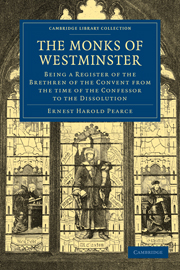 The Monks of Westminster
The Monks of Westminster 2 - INTRODUCTION
Published online by Cambridge University Press: 05 October 2010
Summary
In the course of an article on The Benedictine Abbey of Westminster in the Church Quarterly Review, April, 1907, Dr Armitage Robinson, now Dean of Wells, laid down the lines on which investigations into the history of the Abbey can be most profitably pursued. He paid to Richard Widmore a tribute, to which every searcher among the Muniments will gladly subscribe. He pointed out how much was done by his great predecessor in the Deanery, Dr A. P. Stanley, to familiarise the English people by means of wonderful word-pictures with the innumerable occasions on which the Abbey church has been the scene of stately national functions, and the present writer may venture to add himself to the number of those who, having been children when Stanley was Dean, can now trace their first impression of what Westminster means to one of his vivid addresses at the annual children's service on Holy Innocents' Day.
But Stanley, as Dean Robinson rightly insisted (op. cit. p. 59), “had no kind of sympathy with the monks,” whether the actual denizens of our Convent or the devotees of Benedictinism in general. His heart was with the kings and queens, the courtiers and statesmen, the men of arms and of the toga, whose bodies are buried in peace here, rather than with those whose lot was to offer incense, to prevent with their orisons the dawning of the morning, to make the darkness of the Abbey to be light by burning hundreds of candles round the tombs of the mighty, and in other ways so to commend the monastic vocation to the wealthy and to the powerful that the church and its surrounding buildings were gradually helped on to completion.
- Type
- Chapter
- Information
- The Monks of WestminsterBeing a Register of the Brethren of the Convent from the Time of the Confessor to the Dissolution, pp. 1 - 38Publisher: Cambridge University PressPrint publication year: 2010First published in: 1916
- 2
- Cited by
